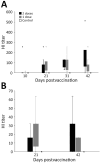Safety and Immunogenicity of Poultry Vaccine for Protecting Critically Endangered Avian Species against Highly Pathogenic Avian Influenza Virus, United States
- PMID: 40233764
- PMCID: PMC12123928
- DOI: 10.3201/eid3106.241558
Safety and Immunogenicity of Poultry Vaccine for Protecting Critically Endangered Avian Species against Highly Pathogenic Avian Influenza Virus, United States
Abstract
In 2023, an outbreak of highly pathogenic avian influenza occurred among critically endangered California condors (Gymnogyps californianus), and >21 died. We evaluated safety, immunogenicity, vaccination strategies, and correlates of antibody response of an influenza vaccine for poultry in black vultures (Coragyps atratus) and then California condors. We noted differences in antibody titers between vaccinated and unvaccinated birds (vultures p<0.004; condors p-<0.02) but no adverse effects of vaccination. All vaccinated vultures and 80% of vaccinated condors showed maximum measured antibody response within the published range associated with survival of vaccinated and virally challenged chickens. We noted weak evidence of higher antibody responses for birds given two 0.5-mL vaccines versus those given one 1-mL vaccine but no correlation between antibody titers and sex for either species or between antibody titers and bone lead concentrations in vultures. Our results prompted initiation of a vaccination program for condors that could reduce spread of this disease among highly threatened species.
Keywords: Black vulture; California condor; Coragyps atratus; Gymnogyps californianus; H5N1; Influenza; United States; highly pathogenic avian influenza virus; inactivated vaccine; respiratory infections; viruses; zoonoses.
Figures


References
-
- United Nations Food and Agricultural Organization. EMPRES-i global animal disease information system [cited 2023 June 27]. https://empres-i.apps.fao.org/diseases
-
- World Organisation for Animal Health. World animal health information system [cited 2023 May 24]. https://wahis.woah.org
-
- Wille M. Ecology and evolution of avian influenza A viruses in wild birds. In: Tibayrenc M, editor. Genetics and evolution of infectious diseases, 3rd edition. London: Elsevier; 2024. p. 863–98.
MeSH terms
Substances
LinkOut - more resources
Full Text Sources
Medical

